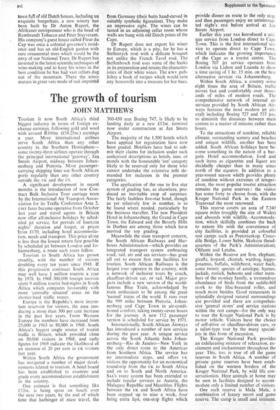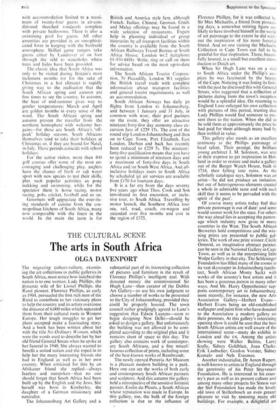The growth of tourism
JOHN MATTHEWS
Tourism is now South Africa's third biggest industry in terms of foreign ex- change earnings, following gold and wool with around R100m. (£58.25m.) earnings a year. More international airlines serve South Africa than any other country in the Southern Hemisphere— some twenty-three airlines operate through the principal international 'gateway', Jan Smuts Airport, midway between Johan- nesburg and Pretoria. More passenger- carrying shipping lines use South African ports regularly than any other country outside the inc. and the us.
A significant development in recent months is the introduction of new Con- tract Bulk Inclusive Tour carriage rates by the International Air Transport Assoc- ciation for its Traffic Conference Area 2. CB1T fares became operative from October last year and travel agents in Britain . now offer all-inclusive holidays by sched-' tiled jet service, for periods of fourteen nights' duration and longer, at prices from £170, including hotel accommoda- tion, meals and transport. This price alone is less than the lowest return fare possible by scheduled jet between London and Jo- hannesburg, a route such tours follow.
Tourism to South Africa has grown steadily, with the number of visitors doubling every ten years since 1948. If this progression continues South Africa may well have million tourists a year by 1978. In 1968 300,000 foreign tourists spent 9 million tourist bed-nights in South Africa which compares favourably with more 'centrally situated' areas on the shorter-haul traffic routes.
Europe is the Republic's most impor- tant reservoir for visitors, the area pro- ducing a more than 300 per cent increase in the past five years. From Western Europe the numbers have increased from 25,000 in 1963 to 80,000 in 1968. South Africa's biggest single source of tourist traffic is Britain, which provided close on 50,000 visitors in 1968, and early figures for 1969 indicate the likelihood of an increase of 20 per cent in UK visitors last year.
Within South Africa the government has instigated a number of major devel- opments related to tourism. A hotel board has been established to examine and grade every accommodation establishment in the country.
One estimate is that something like £32m. is being spent on hotels over the next two years, by the end of which time that harbinger of mass travel, the 360-450 seat Boeing 747, is likely to be landing daily at a new £12m. terminal now under construction at Jan Smuts Airport.
The majority of the 1,500 hotels which have applied for registration have now been graded. Hoteliers have had to sub- mit their claims for inclusion under such authorised descriptions as hotels, inns, or motels with the honourable 'inn' category likely to be reserved only for those who cannot undertake the extensive refit de- manded for inclusion in the premier categories.
The application of the one to five star system of grading has, as elsewhere, pro- duced an inevitable crop of surprises. The fairly faultless five-star hotel, though as yet relatively few in number, is to be found where needed, particularly by the business traveller. The new President Hotel in Johannesburg, the Grand in Cape Town, the Edward and the Beverly Hills in Durban are among those which have merited the top grading.
Meanwhile the state transport concern, the South African Railways and Har- bours Administration—which provides an integrated transport system embracing road, rail, air and sea services—has gone all out to ensure first rate facilities for tourists. South African Railways is the largest tour operator in the country, with a network of inclusive tours by coach, chaeffeur-driven car, or rail. Major pro- jects include a new version of the world- famous Blue Train, acknowledged by train enthusiasts to be among the great `named' trains of the world. It runs over the 999 miles between Pretoria, Johan- nesburg and Cape Town in air-condi- tioned comfort, taking twenty-seven hours for the journey. A new 112 passenger version is scheduled for service by 1971.
Internationally, South African Airways has introduced a number of new services during the past year. A unique service across the South Atlantic links Johan- nesburg—Rio de Janeiro—New York in the only direct route to the Americas from Southern Africa. The service has no intermediate stops, and offers UK visitors the opportunity for an economical round-trip from the ux to South Africa and on to South and North America. SAA'S route system has been extended to include regular services to Austria, the Malagasy Republic and Mauritius. Flights between the UK and South Africa have been stepped up to. nine a week, four being extra fast, one-stop flights which provide dinner en route to the only stop, and then passengers enjoy an uninterrup- ted night's rest before arrival at Jan Smuts Airport. Earlier this year SAA introduced a uni- que service from London direct to Cape Town. This is the first international ser- vice to operate direct to Cape Town, which indicates the growing importance of the Cape as a tourist centre. The Boeing 707 jet service operates from London via Lisbon and Luanda to show a time saving of 1 hr. 15 min. on the best alternative services via Johannesburg.
Within South Africa, a country some eight times the area of Britain, traffic moves fast and comfortably over thous- ands of miles of modern roads. The comprehensive network of internal air services provided by South African Air- ways features the most modern jet air- craft including Boeing 727 and 737 jets, to diminish the distances between main centres to a matter of minutes rather than hours.
To the attractions of sunshine, reliable climate, outstanding scenery and beaches and unique wildlife, another has been added. South African holidays have be- come something in the nature of a bar- gain. Hotel accommodation, food and such items as cigarettes and liquor are decidedly cheaper than in many areas north of the equator. In addition to a year-round season which provides plenty of sunshine without extremes of temper- ature, the most popular tourist attraction remains the game reserves : the visitor has some forty to choose from, with the Kruger National Park in the Eastern Transvaal the most renowned.
This reserve covers an area of 7,340 square miles (roughly the size of Wales) and abounds with wildlife. -Accommoda- tion, which skilfully combines the back to nature life with the convenience of city facilities, is provided at colourful rest camps such as Pretdriuskop, Croco- dile Bridge, Lower Sabie, Skukuza (head- quarters of the Park's Administration), Olifants and Letaba.
Within the Reserve are lion, elephant, giraffe, leopard, cheetah, warthog, hippo- potamus, buffalo, wildebeest, water buck, some twenty species of antelope, hyenas, jackals, ostrich, baboons and other mem- bers of the monkey family, a tremendous abundance of birds from the saddle-bill stork to the lilac-breasted roller, and much more besides. Good restaurants in splendidly designed natural surroundings are provided and there are comprehen- sive 'general stores' and service stations within the rest camps—for the only way to tour the Kruger National Park is by motor vehicle. Visitors have the choice of self-drive or chauffeur-driven cars, or a safari-type tour by the many special- ists in this form of excursion.
The Kruger National Park provides an exhilarating mixture of relaxation, ex- citement and enchantment throughout the year. This, too, is true of all the game reserves in South Africa. A number of private game reserves have been estab- lished on the western borders of the Kruger National Park, by wild life con- servationists. Here animals at home may be seen in facilities designed to accom- modate only a limited number of visitors.
One such reserve is Mala Mala, a combination of luxury resort and game reserve. The camp is small and intimate, with accommodation limited to a maxi- mum of twenty-four guests in air-con- ditioned thatched rondavels complete with private bathrooms. There is also a swimming pool for guests. All other amenities are provided in an unsophisti- cated form in keeping with the bushveld atmosphere. Skilled game rangers 'take guests either by Landrover or on foot through the veld to waterholes where trees and hides have been provided.
The classic idea that South Africa was only to be visited during Britain's most inclement months (or for the sake of Christmas in a hot climate) is rapidly giving way to the realisation that the South African spring and autumn are fine times to see the country. In autumn, the heat of mid-summer gives way to gentler temperatures: March and April are golden months in every sense of the word. The South African spring and autumn present the traveller from the northern hemisphere with welcome bar- gains—for these are South Africa's 'off- . -peak' holiday seasons. South Africans themselves tend to take their holidays at Christmas or. if they are bound for Natal, in July. These periods coincide with school holidays.
For the active visitor, more than 400 golf courses offer some of the most en- couraging and challenging play, anglers have the chance of fresh or salt water sport with new species to test their skills, plus such popular activities as pony trekking and swimming, while for the spectator there is horse racing, motor racing, polo, cricket, football and so on.
Gourmets will appreciate the ever-ris- ing standards of cuisine from the cos- mopolitan kitchens of South Africa, many now comparable with the finest in the world. In the main the taste is for British and America style fare, although French, Italian, Chinese, German, Greek and Malay offerings may be found in a wide selection of restaurants. Expert help in planning individual or group itineraries by all transport facilities within the country is available from the South African Railways Travel Bureau at South Africa House, London wc2 (telephone 01-930 4488). Write, ring or call on them for advice based on the most up-to-date information.
The South African Tourist Corpora- tion, 70 Piccadilly, London WI supplies the British travel trade with complete information about transport facilities and general tourist requirements, as well as accommodation.
South African Airways has daily jet flights from London to Johannesburg, and between 1 January and 31 July. in common with BOAC, their pool partners on the route, they offer an attractive nineteen/forty-five day economy class ex- cursion fare of £229 17s. The cost of the round trip London-Johannesburg and then on to Cape Town, Port Elizabeth, East London, Durban and back has recently been reduced to £229 7s. The nineteen/ forty-five qualification means that you have to spend a minimum of nineteen days and a maximum of forty-five days in South Africa and/or South West Africa. And all- inclusive holidays tours to South Africa by scheduled jet air services are available from £170 for fourteen days. It is a far cry from the days seventy five years ago when Thos. Cook and Son introduced its first excursion, or inclu- sive tour, to South Africa. Travelling by motor launch, the Southern - Africa tour sea, rail, road, coach, ox-wagon and extended over five months and cost in the region of £375.























































 Previous page
Previous page